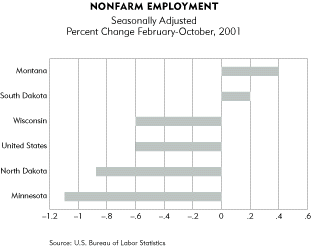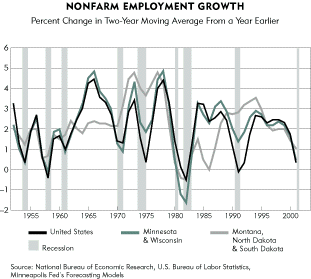The National Bureau of Economic Research recently determined that a recession began in March 2001, in large part due to a peak reached in employment growth. Since March, over 1 million jobs have been lost in the U.S. economy. During previous recessions, employment levels have tended to decrease in the nation and district states, although there are some exceptions. Since 1952, employment growth in Minnesota and Wisconsin has followed the national trend during all time periods, while employment growth in Montana, North Dakota and South Dakota has at times deviated from the nation.

During the previous two periods of recession, that is 1980-1982 and 1990-1991, employment dipped in the district and the nation, but at somewhat different rates. In 1980-1982, the percent decrease in district employment was larger than the nation. However, during 1990-1991, employment growth remained positive in the district, while employment levels decreased nationally.

From February, the month prior to the beginning of the most recent recession, until October, seasonally adjusted nonfarm employment dropped in Minnesota, North Dakota and Wisconsin at rates even or lower than the national average, while employment in Montana and South Dakota increased slightly. Changes in district employment by sector during October roughly mirrored the nation (see "District economy slowed in 2001; expected to remain sluggish in 2002").
Since 1952 employment growth in Minnesota and Wisconsin has closely followed the national trend. However, Montana, North Dakota and South Dakota deviated from the nation during a five-year period in the 1960s, and the farm crisis of the 1980s began a period when employment growth in these states moved in opposite directions from the nation. However, since the mid-1990s employment growth in Montana and the Dakotas has followed the nation.
Differences in population growth and industry and labor composition, as well as changes in agricultural conditions, which have a larger impact on Montana and the Dakotas than on Minnesota and Wisconsin, contribute to divergences among these two sets of states in employment growth.
| INGREDIENTS OF A RECESSION |
|---|
|
The common definition of a recession is two consecutive quarters of decreasing gross domestic product (GDP), that is, the value of goods and services produced in the economy. However, since GDP is published quarterly and is sometimes revised years later, other economic indicators are used to determine when a recession begins and ends. According to the National Bureau of Economic Research (NBER), which determines the peaks and troughs of the business cycle, a recession is a significant decline in economic activity, lasting more than a few months and visible in industrial production, employment, real income and wholesale-retail trade. Other measures also help determine when the economy has reached its highest point (peak) and begins to contract. This marks the beginning of a recession. A recession ends when the economy reaches a trough, the turning point where economic activity begins to expand. The NBER Business Cycle Dating Committee announced on Nov. 26 that a peak in U.S. business activity occurred in March 2001. The points listed below summarize some of the observations the NBER made in reaching its decision.
|





